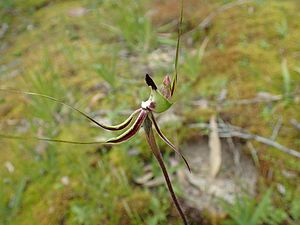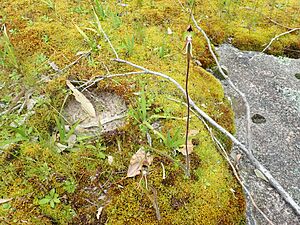Pointing spider orchid facts for kids
Quick facts for kids Pointing spider orchid |
|
|---|---|
 |
|
| Caladenia exstans growing in Cape Le Grand National Park | |
| Scientific classification | |
| Genus: |
Caladenia
|
| Species: |
exstans
|
| Synonyms | |
|
|
The pointing spider orchid, also known as Caladenia exstans, is a special type of orchid. It only grows in a small part of Western Australia, in the south-west region. This unique plant has a single leaf that feels hairy. Its flowers are green, yellow, and red.
One cool thing about this orchid is its "labellum" (a special lip-like petal). Instead of curling down, it points straight forward, which is how it got its name!
Contents
What Does the Pointing Spider Orchid Look Like?
The pointing spider orchid is a plant that grows from the ground. It's a perennial plant, meaning it lives for more than two years. It's also a deciduous herb, which means its leaves fall off at certain times.
Underground, it has a tuber, which is like a small storage organ. From this tuber, a single, upright, hairy leaf grows. This leaf can be about 5 to 20 centimeters (2 to 8 inches) long and 4 to 6 millimeters (0.16 to 0.24 inches) wide.
The plant usually has one or two flowers. These flowers are green, yellow, and red. They are about 4 to 6 centimeters (1.6 to 2.4 inches) long and 3 to 5 millimeters (0.12 to 0.20 inches) wide. The flowers grow on a stem that can be 20 to 45 centimeters (8 to 18 inches) tall.
Each flower has different parts:
- The top petal, called the dorsal sepal, stands upright. It's about 3 to 4.5 centimeters (1.2 to 1.8 inches) long.
- The two side petals, called lateral sepals, are also 3 to 4.5 centimeters (1.2 to 1.8 inches) long. They grow close together and curve forward and up.
- All the sepals have thin, yellowish tips that look like small glands.
- The other petals are about 2 to 3 centimeters (0.8 to 1.2 inches) long and curve backwards.
The most interesting part is the labellum, which is the orchid's special lip. It's about 1.1 to 1.3 centimeters (0.43 to 0.51 inches) long and 1.4 to 1.5 centimeters (0.55 to 0.59 inches) wide. It's attached in a way that lets it move slightly. The labellum is greenish-yellow with a dark reddish-purple tip. This tip doesn't curl under; instead, it points forward, giving the orchid its name.
The edges of the labellum are smooth. In the middle, there are four or more rows of deep red "calli." These are small, raised bumps. This orchid blooms from September to early November.
It can be hard to spot this orchid because its colors blend in with its surroundings. Also, its flowers are quite small on a long stem. However, it's the only green spider orchid with a smooth-edged labellum found east of Esperance.
How the Pointing Spider Orchid Got Its Name
The pointing spider orchid, Caladenia exstans, was first officially described in 2001. Two scientists, Stephen Hopper and Andrew Brown, studied a plant found near Esperance. They published their description in a scientific journal called Nuytsia.
The second part of its scientific name, exstans, comes from a Latin word. It means "projecting" or "sticking out." This refers to the labellum, which points forward instead of curling down.
Where the Pointing Spider Orchid Lives
You can find the pointing spider orchid growing between Esperance and Israelite Bay in Western Australia. This area is part of the Esperance Plains, a special natural region.
The orchid likes to grow in forests where "swamp yate" trees (a type of Eucalyptus) are found. It also grows in shallow soil on or near large granite rocks.
Conservation Status
The Western Australian Government's Department of Parks and Wildlife has looked at the pointing spider orchid. They have classified it as "not threatened." This means it is not currently in danger of disappearing.


